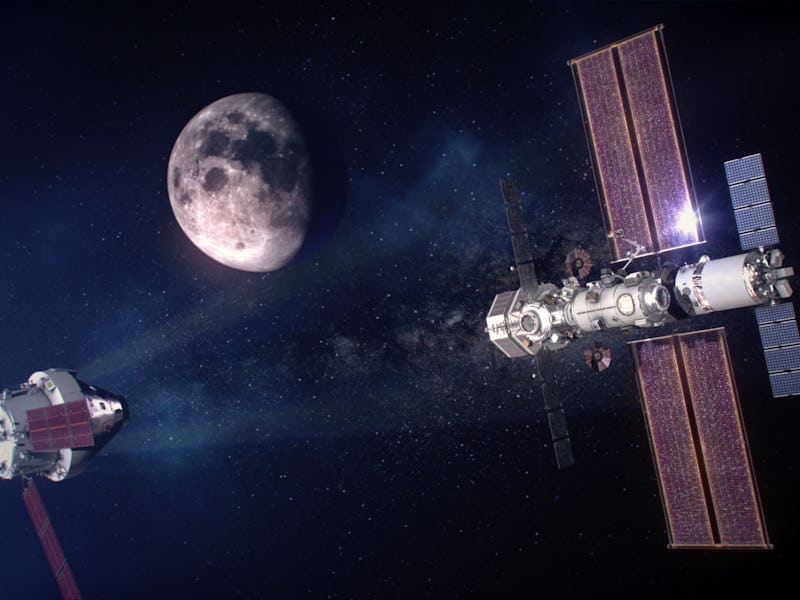NASA Lunar Gateway: Launch window, specs, and orbit of the Moon’s space station
This is huge.

NASA wants to build a giant spaceship to orbit the Moon — but ultimately it’s designed to help send humans to Mars.
The Lunar Gateway is a critical aspect of NASA’s Artemis program, a multi-mission project to return humans to the Moon and set up camp to enable them to venture further out in space than ever before. The Gateway will support these missions by essentially acting as an International Space Station for the Moon. NASA’s mission tagline lays the stakes out:
“To go back to the Moon in 2024 — this time to stay.”
The project will be the first time humans have tried to situate a permanent orbital space station around the Moon.
Here’s everything you need to know about the Lunar Gateway.
What is the Lunar Gateway?
The Lunar Gateway is a crewed space station designed to orbit the Moon. In this sense, it is similar to the International Space Station, which currently orbits the Earth.
Ultimately the Gateway is designed to provide humans with a destination close to the Moon to conduct experiments and complete research projects in space.
The Gateway will also support crewed and unmanned missions to the Moon’s surface. For crewed missions, astronauts will first fly to the Gateway using the NASA Orion spacecraft. Then, they will use a human lander to transfer the astronauts to the Moon’s surface. NASA has selected the SpaceX Starship to act as the human lander — although it remains untested for this purpose.
What is the Lunar Gateway’s orbit?
The Lunar Gateway will operate in a near-rectilinear halo orbit of the Moon. This rather unusual orbit means that, at its shortest point, the Gateway will be 932 miles above the Moon’s surface. At its farthest point, the Gateway will be 43,495 miles above the Moon’s surface.
NASA's diagram of the Gateway's orbit.
It’s still a long way from Earth, however: The station will be around 240,000 miles from Earth, and orbiting Earth alongside the Moon as our natural satellite orbits Earth.
What are the components of the Lunar Gateway?
The Gateway is made up of a series of components. While these components reflect the international collaboration working to bring the project to fruition, none of the components are ready for orbit around the Moon.
NASA's Lunar Gateway design.
NASA’s initial focus is on building and testing the components that will support a human landing on the Moon:
- The Power and Propulsion Element: This is a 60-kilowatt spacecraft that provides power, altitude control, communications, and orbital transfer capabilities.
- The Habitation and Logistics Outpost: This will provide basic life support to the crew members onboard the Gateway.
What size is the Lunar Gateway?
The Lunar Gateway has an internal pressurized volume of 125 cubic meters (4,414 cubic feet). It can house as many as four crew members for 30- to 90-day mission periods.
By comparison, the International Space Station has an internal pressurized volume of 32,333 cubic feet. It typically houses around seven astronauts.
The gateway is expected to be around one-sixth the size of the International Space Station, which itself is around the size of a football field. The BBC notes that the main body of the Gateway is a bit bigger than a London Underground tube carriage.
When will NASA launch the Lunar Gateway?
SpaceX’s Falcon Heavy will send the Lunar Gateway components into space.
The Lunar Gateway’s critical Power and Propulsion Elements and Habitation and Logistics Outposts are scheduled to launch into space no earlier than November 2024.
The launch will use a SpaceX Falcon Heavy rocket, the most powerful operational rocket at the time of writing. This is the same model rocket that SpaceX CEO Elon Musk used to send his red Tesla Roadster car into space in February of 2018.
The mission will launch from Launch Complex 39A at the Kennedy Space Center in Florida.
During the actual Artemis missions, NASA plans to send the humans to the Lunar Gateway using the under-development Space Launch System rocket — this rocket is still very much in the construction phase.
Whether NASA can stick to this timeline remains to be seen, especially after the agency noted in November 2021 that litigation has pushed the first human landing back several months to 2025. Artemis I, which does not involve a crew and is a vital milestone for the Lunar Gateway and later Artemis missions to run on time, has also been pushed back to May of 2022 at the earliest from an earlier date of March 2022.